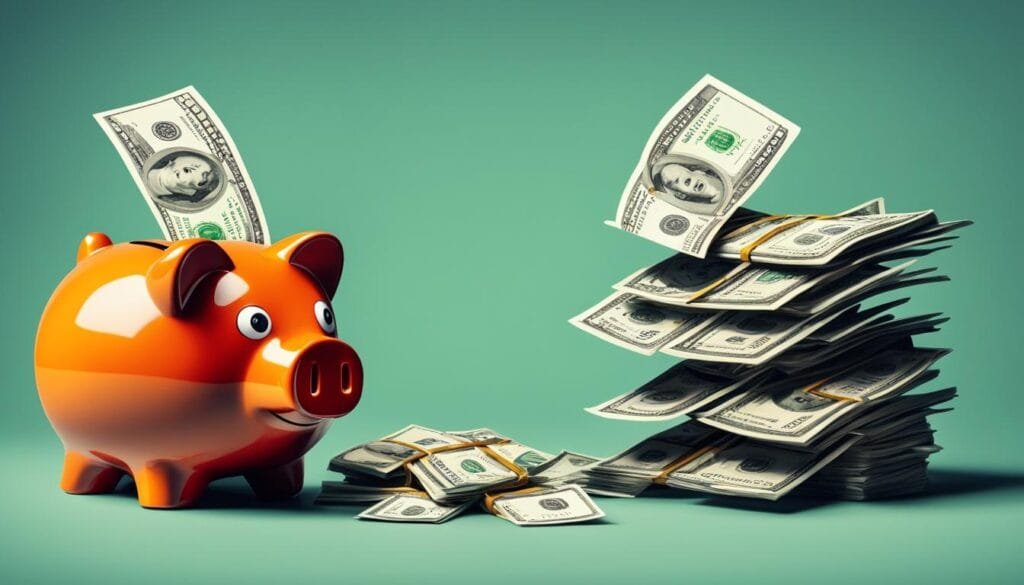Impulse buying is a common behavior that many people experience. Have you ever found yourself making spontaneous purchases without really thinking about it? You’re not alone. Impulse purchases are often driven by psychological factors and emotional advertising, which can be powerful triggers that influence our buying decisions.
Understanding these triggers can help individuals become more aware of their impulse buying behavior and take control of their spending habits. By recognizing the factors that contribute to impulsive purchases, we can make more deliberate and informed decisions about our shopping choices.
Key Takeaways:
- Impulse buying is influenced by psychological factors and emotional advertising.
- Understanding the triggers of impulse buying can help individuals manage their spending habits.
- Awareness of these triggers can lead to more deliberate and informed shopping decisions.
- Recognizing the role of emotions and advertising can help individuals take control of their impulse buying behavior.
- By being mindful of these triggers, individuals can avoid unnecessary and regretful purchases.
The Psychology behind Impulse Buying
Impulse buying is a fascinating behavior deeply rooted in human psychology. Understanding the psychological triggers behind impulse buying can shed light on why we make impulsive purchases and how marketers can effectively tap into these tendencies.
Fear of missing out (FOMO) is a powerful psychological trigger that drives individuals to make impulsive purchases. The fear of being left out or missing out on a desirable experience or product can create a sense of urgency and compel individuals to buy immediately. Marketers often leverage this fear by highlighting limited time offers and scarcity.
Limited time offers are an effective tactic used to create a sense of urgency and scarcity, making consumers feel compelled to buy immediately to secure the product or deal. By creating a perception that the offer is available for a limited time only, marketers tap into the impulse buying behavior of consumers who fear missing out on a great deal.
Scarcity marketing is another strategy that capitalizes on the psychological fear of scarcity. When consumers perceive a product or offer as scarce or exclusive, they are more likely to act impulsively to avoid missing out. Scarcity marketing techniques, such as stating limited stock availability or emphasizing that a product is a rare find, can trigger impulse buying behavior.
Social proof also plays a significant role in impulse buying behavior. People are influenced by the actions and opinions of others, especially those they trust. Positive reviews, recommendations from friends, or testimonials can act as social proof, providing reassurance and validation to individuals considering making an impulsive purchase.
The psychology behind impulse buying reveals the complex interplay of emotions, urgency, scarcity, and social influence. By understanding these psychological triggers, marketers can implement effective strategies to encourage impulse buying behavior and consumers can develop awareness to make more deliberate purchasing decisions.
An Example of Impulse Buying Psychology in Action
“I saw the limited-time offer for the new smartphone and instantly felt a fear of missing out. The ad mentioned that only a few units were left, and I couldn’t resist the urge to buy it immediately, fearing that I would miss out on the deal. The social proof from positive reviews added to the impulse, as I saw others enjoying the latest features. It was a combination of FOMO, limited time offer, and social validation that triggered my impulsive purchase.”
The Role of Scarcity in Impulse Buying
Scarcity is a powerful psychological motivator that drives impulse buying behavior. When individuals perceive a product or opportunity as scarce, they are more likely to act impulsively to secure it. Marketers can leverage scarcity by highlighting limited quantities, exclusive offers, or time-limited deals to create a sense of urgency and trigger impulsive purchases.
| Techniques | Examples in Marketing |
|---|---|
| Countdown timers | Showing a ticking clock to indicate limited time remaining for a discount |
| Stock availability | Stating “Only 3 left in stock” to create a sense of urgency |
| Exclusive releases | Launching limited edition products with a finite number available |
| Flash sales | Offering deals for a short period, encouraging immediate action |
Internal Triggers of Impulse Buying
Internal triggers for impulse buying can stem from emotional states such as loneliness, depression, anxiety, boredom, and stress. These feelings can lead individuals to seek immediate gratification and comfort through impulsive purchases. When experiencing these emotions, individuals may be more susceptible to impulse buying as a way to alleviate negative feelings or fill a void in their lives.
Emotional triggers play an essential role in influencing impulsive buying behavior. Advertisers and marketers capitalize on these emotions by creating emotional advertising campaigns that tap into the underlying psychological needs of consumers. By evoking strong feelings of happiness, excitement, or security, these campaigns create a deep emotional connection between the consumer and the product or experience being promoted, increasing the likelihood of impulsive purchases.
Impulse buying can provide a temporary sense of happiness or relief from emotional distress. Individuals may believe that purchasing a new item will enhance their mood or improve their overall well-being. However, this emotional satisfaction is often short-lived, and impulsive purchases can lead to financial strain and buyer’s remorse.
Understanding the emotional triggers that contribute to impulse buying behavior is vital for individuals to regain control over their spending habits. By recognizing their emotional vulnerabilities and developing healthier coping mechanisms, individuals can avoid succumbing to impulsive purchases driven by negative emotions.
The Role of Emotional Triggers in Impulse Buying
Emotional triggers in impulse buying rely on the notion that individuals may use shopping as a way to regulate their emotions. According to a study published in the Journal of Consumer Psychology, individuals may use retail therapy as a means to cope with negative emotions, seeking comfort and distraction through the act of buying.
Marketers strategically design advertising campaigns and product displays to target specific emotional triggers. By highlighting the emotional benefits of a product or emphasizing how it can alleviate stress, anxiety, or boredom, marketers can effectively sway individuals towards impulsive purchases.
To illustrate this point, consider the example of a television commercial showcasing a family enjoying a relaxing vacation. The imagery and narrative evoke feelings of happiness, togetherness, and escapism, targeting individuals who may be seeking an escape from their everyday lives. This emotional connection established through advertising serves as a powerful internal trigger that can prompt impulsive buying decisions.
Furthermore, retailers strategically position products and create in-store displays that trigger emotional responses. For example, placing enticing items near the checkout counter can capitalize on individuals’ impulsive tendencies at the point of purchase, increasing the likelihood of unplanned buying.
Mapping Internal Emotional Triggers
The table below provides an overview of common internal emotional triggers that can contribute to impulse buying behavior:
| Emotional Trigger | Description |
|---|---|
| Loneliness | Feelings of isolation may drive individuals to seek comfort through material possessions. |
| Depression | Individuals may use impulsive buying as a temporary escape from feelings of sadness or low mood. |
| Anxiety | High levels of stress or anxiety can lead individuals to seek relief through impulsive purchases. |
| Boredom | Feelings of boredom or monotony may prompt individuals to seek excitement through impulsive buying. |
| Stress | Stressful situations can trigger impulsive buying as a form of emotional release or self-soothing. |
Identifying and acknowledging these internal emotional triggers is the first step towards regaining control over impulsive buying behavior. By addressing the underlying emotional needs through healthier alternatives like engaging in hobbies, socializing, or practicing self-care, individuals can reduce the reliance on impulsive purchases as a means of emotional regulation.
Addressing emotional triggers is crucial in managing impulse buying behavior effectively. By recognizing the emotional vulnerabilities and developing healthier coping mechanisms, individuals can regain control over their spending habits and make more intentional purchasing decisions.
External Triggers of Impulse Buying
External triggers play a significant role in driving impulse buying behavior. These triggers include:
- Targeted Advertising: Targeted advertising is designed to catch the consumer’s attention and create a sense of urgency or desire for the product. By leveraging data and analytics, advertisers can deliver personalized messages to specific individuals, increasing the likelihood of impulse purchases.
- In-store Displays: In-store displays strategically position products in high-traffic areas, making them easily accessible and tempting for impulse purchases. By showcasing products in an eye-catching and visually appealing manner, retailers can capture the attention of shoppers and encourage spur-of-the-moment buying decisions.
- Discounts and Sales: Discounts and sales promotions further stimulate impulse buying by offering perceived value and savings. Limited-time promotions, such as “Buy One, Get One Free” or “50% Off for Today Only,” create a sense of urgency and encourage consumers to make impulsive purchases in order to take advantage of the discounted prices.
These external triggers exploit consumers’ desire for immediate gratification and the thrill of acquiring a perceived good deal. By leveraging targeted advertising, in-store displays, and discounts and sales promotions, retailers and advertisers can effectively influence consumer behavior and drive impulse purchases.

Image: A targeted advertising campaign capturing the attention of consumers.
The Role of Mental Biases in Impulse Buying
Mental biases significantly influence impulse buying behavior, leading individuals to make spontaneous purchases based on irrational decision-making processes. Two prominent mental biases associated with impulse buying are anchoring bias and loss aversion.
Anchoring Bias
Anchoring bias occurs when individuals rely heavily on the initial information or prices they encounter when making purchasing decisions. They tend to anchor their perception of value to the initial reference point, which can often be influenced by external factors such as past experiences or price tags on similar products.
This bias can have a profound impact on impulse buying decisions as it may cause individuals to overvalue or overestimate the worth of a product based on the anchoring reference point. For example, if a consumer sees a higher-priced item initially, they may perceive a lower-priced item as a bargain and make an impulsive purchase without considering its true value.
Loss Aversion
Loss aversion is another mental bias that plays a significant role in impulse buying behavior. It refers to the tendency of individuals to strongly react to potential losses compared to equivalent gains. In the context of impulse buying, individuals are driven to make impulsive purchases out of fear of missing out on a potential gain or losing out on the opportunity altogether.
This bias can lead individuals to make impulsive buying decisions without careful consideration of their actual needs or financial circumstances. The fear of missing out on a limited-time offer or exclusive deal can override rational thinking and compel individuals to make spontaneous purchases.
Understanding these mental biases is crucial for both consumers and marketers. Consumers can become more aware of their susceptibility to these biases and develop strategies to manage them, such as setting spending limits or seeking second opinions before making impulsive purchases. Marketers can leverage these biases to create persuasive strategies that appeal to consumers’ emotions and maximize impulse buying opportunities.

By being aware of mental biases such as anchoring bias and loss aversion, individuals can make more informed and rational decisions when it comes to impulse buying. Overcoming these biases requires conscious effort and a focus on evaluating purchases based on their true value and personal needs, rather than succumbing to impulsive urges.
Strategies to Avoid Impulse Buying
To avoid falling into the trap of impulsive purchases, it’s crucial to implement effective strategies that promote conscious decision-making. By setting spending boundaries, minimizing external triggers, and adopting a more deliberate approach to purchasing, individuals can regain control over their finances and make mindful choices.
1. Setting Spending Boundaries
A fundamental strategy for avoiding impulse buying is to establish clear spending boundaries. This can be achieved through budgeting and creating a financial plan that sets limits on discretionary spending. By tracking expenses, individuals gain a clearer understanding of their financial health and can prioritize needs over wants.
“Setting a budget ensures that your spending aligns with your financial goals and prevents impulsive purchases.”
By having a predefined spending limit for non-essential items, individuals are less likely to make impulsive purchases that exceed their financial means. This practice encourages mindfulness and helps curb the desire for immediate gratification.
2. Minimizing External Triggers
External triggers, such as targeted advertising and in-store displays, can significantly impact impulsive buying behavior. To minimize exposure to these triggers, individuals can take proactive steps:
- Unsubscribe from marketing emails that promote sales or discounts, reducing the temptation to make impulsive purchases based on limited-time offers.
- Avoid shopping malls and other retail environments where the prevalence of attractive displays can entice impulse buying.
- Limit time spent on social media platforms that feature targeted advertisements, celebrity endorsements, or influencer recommendations, as these can trigger the urge to make unplanned purchases.
By minimizing external triggers, individuals can create an environment that supports conscious decision-making and reduces impulsive spending.
3. Conscious Decision-Making
Conscious decision-making is a key strategy in avoiding impulse buying. Instead of succumbing to impulsive urges, individuals should take the time to consider the reasons behind their desire to make a purchase and evaluate the potential consequences.
“Pause and reflect on whether the item aligns with your values, needs, and long-term financial goals.”
This conscious evaluation can help individuals identify whether the purchase is truly essential and brings long-term value or if it is merely a fleeting desire driven by the momentary excitement of the impulse. By consciously weighing the pros and cons, individuals can make rational decisions that align with their priorities and financial well-being.
Implementing these strategies to avoid impulse buying empowers individuals to regain control over their spending habits, make more intentional purchases, and ultimately achieve financial stability and peace of mind.

Are Impulse Buying Triggers and Market Timing Myths Related in Any Way?
Impulse buying triggers and bizarre market timing myths are not directly related. However, both can influence consumer behavior. Impulse buying triggers prompt quick, unplanned purchases, while bizarre market timing myths can lead investors to make irrational decisions based on unfounded beliefs about the best time to buy or sell.
Conclusion
Impulse buying is a behavior influenced by a combination of internal and external triggers. Psychological factors, such as emotions and the desire for immediate gratification, play a significant role in impulse buying. Additionally, targeted advertising, in-store displays, and sales promotions are external triggers that tempt individuals to make impulsive purchases.
Understanding the psychology behind impulse buying is crucial for managing and avoiding impulsive purchases. By setting spending boundaries and consciously making decisions, individuals can regain control over their impulse buying behavior. It is also beneficial to minimize exposure to external triggers, such as unsubscribing from marketing emails and reducing time spent on social media.
By adopting these strategies, individuals can make more intentional purchasing decisions and resist the urge to make impulsive purchases. Taking control of impulse buying behavior allows individuals to align their spending with their priorities and financial goals, ultimately leading to more mindful and satisfying consumption.
FAQ
What are some common triggers for impulse buying?
Common triggers for impulse buying include emotional factors such as excitement and the desire for immediate gratification, targeted advertising, in-store displays, and sales promotions.
What is the role of fear of missing out (FOMO) in impulse buying?
Fear of missing out (FOMO) is a powerful psychological trigger that drives individuals to make impulsive purchases to avoid feelings of regret or exclusion.
How do limited time offers and scarcity marketing influence impulse buying?
Limited time offers and scarcity marketing create a sense of urgency and scarcity, making consumers feel compelled to buy immediately to secure the product or deal.
How does social proof impact impulse buying behavior?
Social proof, such as positive reviews or recommendations from friends, influences impulse buying behavior by providing reassurance and validation.
What are some internal triggers for impulse buying?
Internal triggers for impulse buying stem from emotional states such as loneliness, depression, anxiety, boredom, and stress.
How do targeted advertising and in-store displays contribute to impulse buying?
Targeted advertising is designed to catch the consumer’s attention and create a sense of urgency or desire for the product, while in-store displays strategically place items in high-traffic areas, making them easily accessible and tempting for impulse purchases.
What role do mental biases play in impulse buying?
Mental biases, such as anchoring bias and loss aversion, can cloud rational thinking and influence impulsive buying decisions.
What strategies can help individuals avoid impulse buying?
Strategies to avoid impulse buying include setting clear spending boundaries, minimizing exposure to external triggers, and making conscious and deliberate purchasing decisions.

